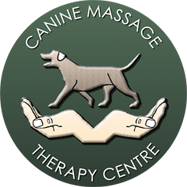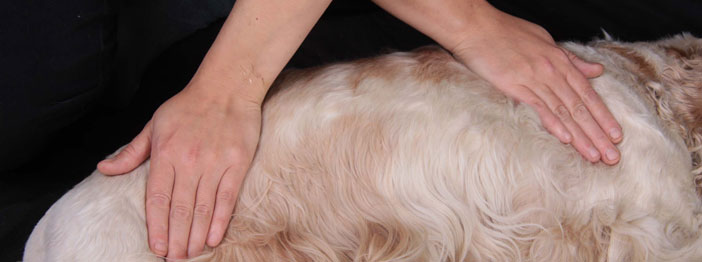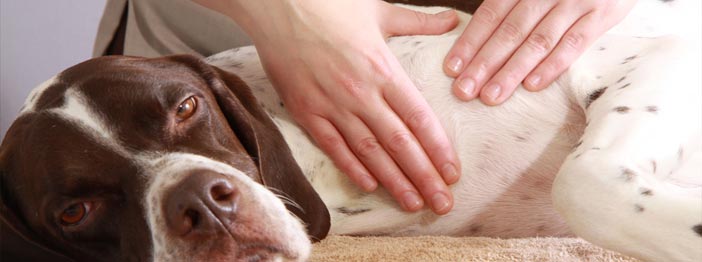“A Myofascial trigger point is a point found in a nodule or taut band of skeletal muscular tissue that is extremely tender and refers or radiates pain in a characteristic pattern. Trigger points are produced by muscle stress such as overwork, repetitive motion or sudden excessive stretch. “
(Clay & Pounds 2008)
The most common muscular issue in a dog is undoubtedly the Trigger Point. We all have trigger points and they are a fact of life. However, when Trigger Points cause debilitating pain, restricted ROM or affect your dogs quality of life it really is time to do something about it. And that’s where massage can help.
Trigger Points cause:
– Chronic ongoing pain
– Pain that likes to mimic the symptoms of other issues
– Nerve irritation
– Patterns of Pain Referral eg: commonly seen as self mutilation as dog gnaws at area of pain which is actually coming from a different area.
– Worsening of orthopaedic pain eg: Hip Dysplasia, Arthritis
– Worsening of mobility issues in active and senior dogs
– Ischemia (oxygen and nutrient depravation to the muscle causing weakness)
– Premature ageing (yes something can be done!)
– A grumpy dog, not happy to be handled
What you may see:
– Twitching or flinching of the skin
– Dog screams/yelps when picked up or handled
– Unwilling to be groomed/examined in a certain area eg: behind shoulder/back of rear legs
– Overly sensitive to handling
– A ‘tickly’ spot – not tickly at all, see your dogs grimace, that’s discomfort from a TrP!
– Coat changes in a confined area
– Fatigues quickly on walks
– Unwilling to exercise
– Weight gain through difficulty exercising
– Stiff when rising
– Weakness on hindlimbs
– Lack of co ordination
– Lack of proprioception
– Reduced performance eg: slowed down
Why do they happen?
– Repetitive activity
– Injury
– Primary orthopaedic issue resulting in protective muscle splinting
– Enforced cage rest
– Age
– Accident
– Postural changes
– Persistent shoulder barging/body slamming
– When left untreated for long periods of time they will make permanent changes in the tissue
– Over use
“A hyperirritable locus within a taut band of skeletal muscle, located in the muscular tissue and/or its associated fascia. The spot is painful on compression and can evoke characteristic referred and autonomic phenomena” (Travell 1999)
1-3 sessions of Canine Massage from Canine Massage Guild Member will reduce or resolve the symptoms you have been seeing when it is linked to Trigger Points and Myofascial Pain.
Myofascial Release and Trigger Point Massage Therapy are undoubtedly the best ways to help relieve or resolve these hyperalgesic patches of tissue and to get improvements in the condition, quickly. So keep reading to find out the secrets of the Trigger Point, this highly underestimated common yet subtle cause of chronic pain.
What happens?
A healthy muscle is pliable, is not tender to pressure, does not have tight bands within it and is not reactive to touch. When Trigger Points are present, bands of skeletal muscle have bound together and become compressed and contracted, in often what is referred to as, a ‘knot’. The muscle fibres sustain this contraction which lead to a Pain Cycle, which can mimic, cause and complicate other mobility issues and are a common issue in relation to Orthopaedic Conditions and the Muscular Strain.
A muscle that holds Trigger Points suffers from ‘fake or faux fatigue’. Trigger Points can also mimic the symptoms of other diseases such as Arthritis.
“A hyperirritable band of focul point tension whereby the fibres in the muscles have stayed in a contracted state due to the restrictive binding of the fascia that surrounds them. This produces ischemia, nerve irritation, tenderness, muscular fatigue, reduced ROM and referred pain. Commonly the patient will experience hyperalgesia, an abnormally heightened sensitively to pain, when the area is pressed upon on the precise location”.(Natalie Lenton)
How Trigger Point Release in Canine Massage helps:
Overall when Trigger Points are addressed your dog will be more comfortable, willing and able to exercise, be more active and have an improved mood/behaviour
– Reduced or resolved pain
– Strengthen muscle by releasing the restrictive bands
– Improves Range of Motion
– Dog is more willing to be touched/groomed/petted/examined
– It can address, resolve and support chronic ongoing pain with great success and is key to Pain Management
– The dog finds it easier to settle/improved sleep quality
– Improved sporting performance with reduced recovery periods
– The competent therapist can locate specific areas of Trigger Points.
When working with Trigger Points the adept therapist should be able to locate the exact point and is often able to momentarily reproduce the patients pain.
Some Trigger Points can be completely resolved. Others can be temporarily released so that the muscle may be reeducate itself. Keep in mind that trigger points which have been stored in the body for a long time WILL cause permanent tissue change. All the more reason to get your dogs TrP’s addressed now.
Re establishes para sympathetic activity by inhibiting the excitability of neurons
Reduces mental and physical stress by inhibiting sympathetic response of tissue
Many owners report a much happier demeanor in their dog along with improved exercise level
Dogs will often become more sociable and play more as they no longer ‘guard’ and ‘protect’ the areas they are in pain.
Give it 3 sessions over 3 weeks and see if it works for your dog. Prepare to be amazed. Find your Canine Massage Guild Therapist today.
Note for vets:
Trigger Point or Myofascial Pain is quite often the missing link that is not being addressed in your patients pain cycle. Quite often Trigger Point and Myofascial Pain is NSAID resistant and importantly will only mask not directly address the issue.
Trigger Point therapy is suitable for NSAID intolerant patients, those who do not respond to NSAIDS, renal failure, patients with gastrointestinal intolerances. The Canine Massage Guild therapist works with vet consent to acknowledge and respect the Veterinary Act 1966 and Exemptions Order 1962 and will provide you with a written report.
Is there a Trigger Point for dogs like with humans?
Yes, the student on the Clinical Canine Massage Practitioner Programme will receive a full BodyMap of TrPs. We cannot however give patterns of pain referral as this relies on verbal client feedback in the human. Sorry but this is not for sale to the general public.
To find a therapist in your area, check out the “Find a Therapist” page






